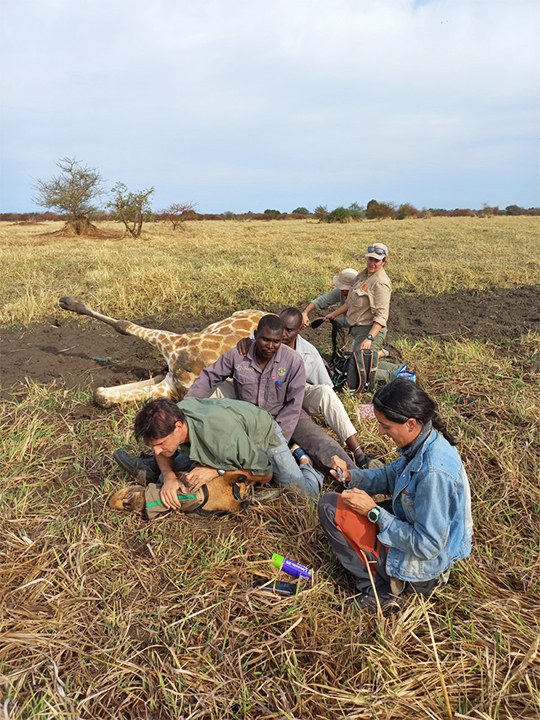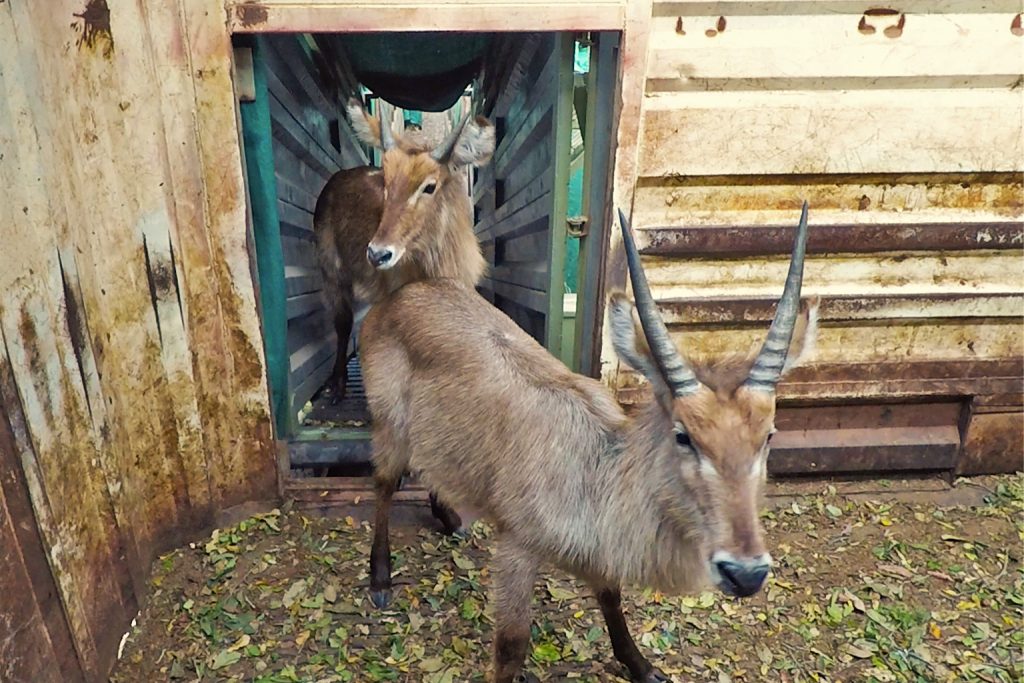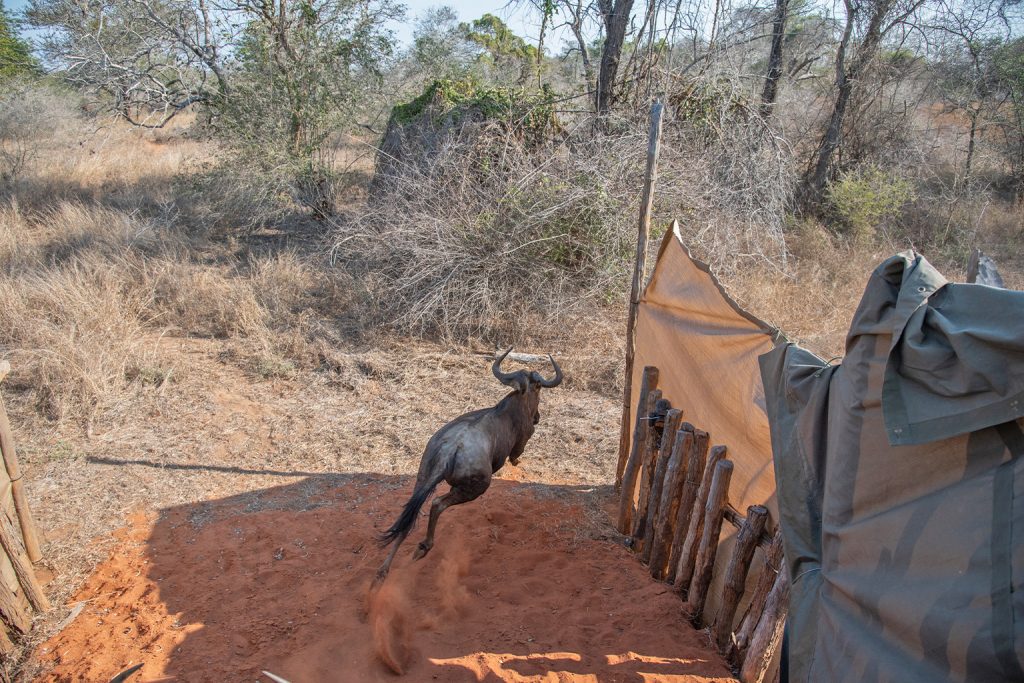Africa’s lion population has experienced a significant decline, dropping by 43% in just 21 years. This alarming trend classifies lions as vulnerable, meaning they are at a high risk of extinction in the wild. However, there is hope for these majestic creatures. Conservation efforts focused on creating large protected landscape mosaics, which include natural corridors beyond core protected lands, are showing promise. By considering the extensive areas lions need to roam seasonally, these projects are not only benefiting lion populations but also contributing to the overall health of ecosystems and the well-being of local communities. Successful examples include the restoration of Zinave National Park in Mozambique and the Greater Zakouma Ecosystem in Chad, which have seen the return of lions through efforts to reintroduce key species and improve habitat. The collaboration between multiple stakeholders and the implementation of similar conservation approaches in other protected areas are vital for the continued success of lion conservation in Africa, such as seen in Kafue National Park in Zambia.

Factors contributing to the decline in lion population
Habitat loss and fragmentation
Habitat loss and fragmentation have been major factors contributing to the decline in the lion population. With increasing human populations and expanding agricultural activities, significant portions of lion habitats have been converted into farmlands, settlements, and infrastructure development. This loss of natural habitat has greatly impacted the ability of lions to find suitable territories, resulting in their decline.
Human-wildlife conflict
Human-wildlife conflict is another significant factor that has contributed to the decline in lion populations. As human settlements encroach upon lion habitats, conflicts arise due to competition for resources and perceived threats to human livelihoods. In response, lions are often targeted and killed as a means of protecting lives and livelihoods, leading to population declines.
Loss of prey species
Lions primarily rely on prey species such as antelope, buffalo, and zebra for survival. However, the loss of prey species due to overhunting, habitat degradation, and competition with livestock has resulted in food scarcity for lions. This scarcity of prey has led to increased lion-human conflicts and has negatively impacted lion populations.
Illegal wildlife trade
Illegal wildlife trade, including the trafficking of lion parts and products, has had a detrimental impact on lion populations. The demand for lion bones, skins, and other body parts, particularly in traditional medicine and trophy hunting industries, has fueled poaching and illegal hunting. This trade has contributed to the decline in lion populations and threatens their survival.
Disease outbreaks
Disease outbreaks, such as canine distemper and bovine tuberculosis, have had severe impacts on lion populations. These diseases can spread rapidly within lion communities, leading to high mortality rates. Additionally, disease outbreaks can weaken lion populations, making them more susceptible to other threats and further contributing to their decline.
The role of protected landscape mosaics in lion conservation
Definition and importance
Protected landscape mosaics encompass a combination of core protected areas and surrounding landscapes that allow for seasonal movements of wildlife. They are essential for lion conservation as they address the need for large roaming areas and connectivity between fragmented habitats. By creating a network of protected areas, lion populations can thrive and maintain healthy genetic diversity, ultimately contributing to their long-term survival.
Creation of large protected landscape mosaics
Creating large protected landscape mosaics involves establishing and connecting multiple protected areas through the inclusion of corridors and buffer zones. This approach considers the natural behaviors and movement patterns of lions and ensures that their seasonal roaming areas are protected. Large protected landscape mosaics provide the space and resources necessary for lions to thrive and adapt to changing environmental conditions.
Consideration of seasonal roaming areas
A crucial aspect of lion conservation is the consideration of seasonal roaming areas within protected landscape mosaics. Lions have distinct migration patterns and rely on different resources in different seasons. By identifying and protecting these areas, lions can access adequate food, water, and breeding opportunities throughout the year, reducing their vulnerability to threats and increasing their chances of survival.
Success stories: Zinave National Park and the Greater Zakouma Ecosystem
Zinave National Park in Mozambique and the Greater Zakouma Ecosystem in Chad serve as successful examples of protected landscape mosaics for lion conservation. These areas have implemented comprehensive conservation strategies that prioritize the preservation of lion habitats and the restoration of natural corridors. Through these efforts, both Zinave National Park and the Greater Zakouma Ecosystem have witnessed the recovery and growth of lion populations.
Importance of wildlife corridors
Wildlife corridors play a crucial role in the success of protected landscape mosaics for lion conservation. These corridors connect fragmented habitats and allow for the movement of lions and other wildlife between protected areas. By providing safe passage and reducing human-wildlife conflicts, wildlife corridors ensure the long-term viability of lion populations and promote ecological connectivity within the landscape.
Successful lion conservation projects
Restoration of Zinave National Park in Mozambique
The restoration of Zinave National Park in Mozambique stands as a notable success in lion conservation. Through collaborative efforts between the Government of Mozambique, local communities, and conservation organizations, the park has been revitalized. Habitat restoration initiatives, anti-poaching measures, and community engagement programs have led to the recovery of the lion population, demonstrating the effectiveness of integrated conservation approaches.
Greater Zakouma Ecosystem in Chad
The Greater Zakouma Ecosystem in Chad is another remarkable example of successful lion conservation. Conservation organizations and the Chadian government have worked hand in hand to restore and protect this critical ecosystem. By implementing strict anti-poaching measures, improving law enforcement, and involving local communities in conservation efforts, the lion population in the Greater Zakouma Ecosystem has rebounded, showcasing the power of collaboration in achieving conservation goals.
Efforts in reintroducing key species
In addition to habitat restoration and protection, reintroducing key species has played a vital role in successful lion conservation projects. By reintroducing prey species such as buffalo and zebra, the ecological balance has been restored, ensuring a stable food supply for lions. These efforts have not only benefited lions but also other wildlife species and the overall health of the ecosystem.
Improvement of habitat conditions
Improving habitat conditions is crucial for the long-term survival of lion populations. Conservation projects have focused on restoring degraded habitats, controlling invasive species, and promoting sustainable land management practices. By creating suitable habitats, lions can thrive, reproduce, and establish more stable populations, contributing to their conservation and the preservation of their ecosystems.
Collaborative conservation efforts
Importance of collaboration
Collaboration is a key factor in successful lion conservation efforts. Conservation organizations, governments, local communities, and other stakeholders must work together to address the complex challenges faced by lion populations. By sharing knowledge, expertise, and resources, collaborative efforts can achieve more significant and long-lasting conservation outcomes.
Involvement of multiple stakeholders
The involvement of multiple stakeholders is essential for successful lion conservation. Local communities, who live in close proximity to lion habitats, possess valuable traditional knowledge and can actively participate in conservation initiatives. Governments can provide the necessary legal frameworks and resources, while conservation organizations bring expertise and technical support. By engaging stakeholders at all levels, comprehensive conservation strategies can be implemented.
Integration of varied land uses
Successful lion conservation often involves the integration of varied land uses within protected areas and landscape mosaics. Balancing conservation goals with the socio-economic needs of local communities is crucial to ensure sustainable coexistence. This integration may involve implementing community-based conservation projects, promoting sustainable tourism, and supporting alternative livelihood initiatives, all of which contribute to the long-term success of lion conservation.
Examples of successful collaborations
There are numerous examples of successful collaborations in lion conservation efforts. The Lion Recovery Fund, a partnership between philanthropic organizations and conservation experts, supports projects worldwide that aim to recover lion populations. The Mara Lion Project in Kenya works closely with local Masai communities to mitigate human-lion conflicts and conserve lion habitats. These collaborations demonstrate the power of collective action in safeguarding lion populations for future generations.

Conservation approaches in other protected areas
Kafue National Park in Zambia
Kafue National Park in Zambia has implemented similar conservation strategies to protect lion populations. By establishing protected landscape mosaics, including buffer zones and wildlife corridors, the park ensures the connectivity and survival of lion habitats. The integration of community-based conservation programs has also contributed to the sustainable management of the park and the conservation of its diverse wildlife.
Implementing similar conservation strategies
Drawing lessons from successful lion conservation projects, other protected areas are implementing similar conservation strategies. By prioritizing large landscape conservation and considering the ecological needs of lions, these areas are taking proactive measures to protect and restore lion habitats. Such strategies are crucial for reversing the decline in lion populations and ensuring their long-term survival.
Learning from successful projects
Learning from successful projects is vital in improving conservation efforts for lion populations. By studying the approaches, challenges, and outcomes of successful projects, conservation practitioners and stakeholders can adapt and replicate effective strategies. This sharing of knowledge and experiences helps build a collective understanding of lion conservation and fosters the development of innovative solutions for future conservation initiatives.
The reconnection of protected areas through wildlife corridors
Definition and purpose of wildlife corridors
Wildlife corridors are linear strips of natural habitat that connect fragmented areas and enable the movement of wildlife between protected areas. These corridors are designed to mimic the natural pathways animals use for migration, dispersal, and finding resources. The purpose of wildlife corridors is to maintain genetic diversity, reduce isolation, and promote the survival of wildlife populations, including lions.
Benefits for lion populations
The reconnection of protected areas through wildlife corridors offers several benefits for lion populations. Lions require large territories to roam and find suitable mates, prey, and resources. By establishing wildlife corridors, lions can move between different areas, access seasonal habitats, and maintain gene flow, ensuring the long-term viability of their populations. Additionally, wildlife corridors help reduce human-lion conflicts by directing lions away from human settlements.
Examples of successful wildlife corridor projects
Several successful wildlife corridor projects have had a positive impact on lion populations. The Niassa Wildlife Corridor in Mozambique, for example, connects Niassa National Reserve with other protected areas, allowing lions to move freely and contribute to the recovery of their populations. Similarly, the Kasungu-Zomba wildlife corridor in Malawi has played a significant role in reconnecting fragmented habitats, benefiting lion populations and other wildlife species.

Effects of reintroducing key species
Impact on lion populations
Reintroducing key species, such as prey animals, has positive effects on lion populations. By restoring the natural prey base, lions have access to an abundant food supply, reducing their dependence on livestock and decreasing human-lion conflicts. The presence of prey also increases the reproductive success of lion populations, leading to population growth and stability.
Ecological benefits
The reintroduction of key species not only benefits lion populations but also has broader ecological benefits. Prey animals play vital roles in balancing ecosystems, regulating vegetation growth, and dispersing seeds. With the return of prey populations, the ecosystem can rebound, promoting biodiversity and enhancing the overall health and functioning of the ecosystem.
Challenges and concerns
While the reintroduction of key species has proven successful, it is not without challenges and concerns. Ensuring the compatibility of reintroduced species with the habitat and existing wildlife populations is crucial to avoid negative ecological impacts. Additionally, careful monitoring and management are required to mitigate potential conflicts between reintroduced species, local communities, and other stakeholders.
Improving habitat conditions for lions
Importance of quality habitat
Quality habitat is essential for the survival and conservation of lion populations. Lions require suitable habitats that offer adequate shelter, water sources, and prey. Improving habitat conditions ensures that lions can find and access these resources, supporting their population growth and resilience.
Effects of habitat degradation
Habitat degradation, such as deforestation, pollution, and invasive species, negatively impacts lion populations. Degraded habitats provide limited food and water resources, increase the risk of disease transmission, and fragment lion populations. Addressing habitat degradation through restoration and conservation efforts is crucial for maintaining healthy and viable lion populations.
Strategies for habitat improvement
To improve habitat conditions for lions, various strategies can be implemented. These include reforestation initiatives, wetland restoration, and the control of invasive plant species. Implementing sustainable land management practices, such as rotational grazing and fire management, can also contribute to habitat improvement by promoting healthy vegetation and reducing habitat degradation.
Case studies on successful habitat restoration
Successful habitat restoration projects provide valuable insights into the impact of improving habitat conditions for lions. The Burunge Wildlife Management Area in Tanzania, for example, has implemented habitat restoration initiatives, resulting in increased prey availability and improved lion reproductive success. Similarly, efforts to restore wetlands and grasslands in the Okavango Delta in Botswana have led to an increase in lion populations and their prey.

The importance of collaboration for successful conservation
Overcoming challenges through collaboration
Collaboration is essential for overcoming the complex challenges faced in lion conservation. By bringing together diverse stakeholders, such as governments, conservation organizations, local communities, and researchers, collective efforts can address issues holistically. Collaboration enables the pooling of resources, knowledge, and expertise, leading to more effective solutions and greater chances of success.
Involvement of local communities
Involving local communities is a crucial component of successful lion conservation. Local communities often have invaluable traditional knowledge and can play active roles in conservation initiatives. By engaging communities in decision-making processes, providing sustainable livelihood opportunities, and promoting environmental education, their support and participation can be secured, leading to long-term conservation success.
Cooperation between government and NGOs
Cooperation between governments and non-governmental organizations (NGOs) is essential for successful lion conservation. Governments can provide the legal frameworks, policy support, and resources necessary for effective conservation. NGOs, on the other hand, can contribute technical expertise, funding, and on-the-ground implementation strategies. Through collaboration, governments and NGOs can leverage their respective strengths, leading to more efficient and impactful conservation efforts.
International collaboration
International collaboration is critical for conserving lion populations across their range. Lions are not confined to national boundaries, and their conservation requires coordinated efforts across countries. International agreements, such as the Convention on International Trade in Endangered Species (CITES), facilitate information exchange, joint conservation initiatives, and the enforcement of wildlife protection measures. By working together globally, the conservation community can better address the challenges facing lion populations.
Conclusion
The decline in lion populations is a pressing concern that requires immediate attention and comprehensive conservation efforts. Factors such as habitat loss, human-wildlife conflict, loss of prey species, illegal wildlife trade, and disease outbreaks have contributed to the decline in lion populations. However, solutions exist, and successful lion conservation projects offer hope for the future.
Protected landscape mosaics, which involve the creation of large interconnected habitats and the consideration of seasonal roaming areas, play a crucial role in lion conservation. Success stories, such as the restoration of Zinave National Park in Mozambique and the Greater Zakouma Ecosystem in Chad, demonstrate the effectiveness of protected landscape mosaics and the importance of wildlife corridors.
Collaborative conservation efforts, involving multiple stakeholders and integrating varied land uses, are necessary to achieve successful lion conservation. Examples of successful collaborations, such as the Lion Recovery Fund and the Mara Lion Project, highlight the positive outcomes that can be achieved through collective action.
Conservation approaches in other protected areas, like Kafue National Park in Zambia, provide valuable insights into effective lion conservation strategies. Learning from these successful projects, replicating successful strategies, and implementing similar approaches are essential for the long-term survival of lion populations.
The reconnection of protected areas through wildlife corridors is crucial for maintaining genetic diversity and promoting the survival of lion populations. Reintroducing key species and improving habitat conditions are also critical components of lion conservation strategies.
Lastly, collaboration remains the cornerstone of successful conservation efforts. By overcoming challenges through collaboration, involving local communities, fostering cooperation between governments and NGOs, and promoting international collaboration, lion populations can be safeguarded for future generations.
The urgent need for lion conservation cannot be overstated. While successes have been achieved in conservation efforts, challenges persist. Continued commitment, innovative approaches, and informed decision-making are necessary to ensure the future survival of these majestic creatures and the protection of their ecosystems. The time to act is now.


